Expansion Planning of Power Distribution Systems Considering Reliability: A Comprehensive Review
Abstract
:1. Introduction
- A comprehensive survey of works that address the expansion planning problem considering reliability in PDS;
- A comparison including the main features and contributions of each work;
- A comparison of methods including decision variables, reliability indices, and the larger-scale test system used of each article; this comparison can be used as a guide to applying the most suitable method according to the requisites of the system;
- An analysis on the computational complexity of optimization models applied to solve the PDS expansion problem considering reliability;
- A discussion about future research trends in optimization models applied to the problem of PDS expansion planning considering reliability.
2. Expansion Planning and Reliability in Power Distribution Systems
2.1. Reliability Indices
2.2. Reliability Evaluation in Expansion Planning Studies
2.3. Test Systems Used in Power Distribution Studies
3. Short- and Long-Term PDS Expansion Planning Considering Reliability
3.1. Protection and Switching Devices in the Context of PDS Expansion Planning
3.2. Substation and Feeders within PDS Expansion Planning
4. PDS Expansion Planning Considering Reliability and DER
4.1. Distributed Generation
4.2. Energy Storage Systems
4.3. Parking Lots with Charging Stations for Electric Vehicles
5. Comparative Analysis
5.1. Decision Variables
- Replacement of protection devices [91];
- Allocation of NC switches and fault indicator devices [67];
- Allocation of single-phase or three-phase fuses and reclosers [89];
- Allocation of NC switches and CB [59];
- Allocation of reclosers and CB [70];
- Allocation of reclosers [93];
- Allocation of sectionalizing switches, fuses and CB [65].
5.2. Reliability Indices
5.3. Computational Complexity
6. Future Research Trends
7. Conclusions
Author Contributions
Funding
Institutional Review Board Statement
Informed Consent Statement
Conflicts of Interest
Abbreviations
| ACO | Ant Colony Optimization |
| AENS | Average Energy Not Supplied |
| AL | Addition of Lines |
| ASAI | Average Service Availability Index |
| BB | Branch and Bound |
| BC | Branch and Cut |
| CAIDI | Customer Average Interruption Duration Index |
| CB | Circuit Breakers |
| CDF | Customer Damage Function |
| CIC | Customer Interruption Cost |
| CID | Customer Interruption Duration |
| CIF | Customer Interruption Frequency |
| CNS | Customers Not Supplied |
| CS | Charging Stations |
| DER | Distributed Energy Resources |
| DP | Dynamic Programming |
| DPSO | Discrete Particle Swarm Optimization |
| DG | Distributed Generation |
| EA | Evolutionary Algorithm |
| EV | Electric Vehicles |
| ECOST | Expected Interruption Cost Index |
| ENS | Energy Not Supplied |
| ESS | Energy Storage Systems |
| FIM | Fault Incidence Matrix |
| GA | Genetic Algorithm |
| GAL | Greedy Algorithm |
| IEEE | Institute of Electrical and Electronics Engineers |
| M | Multistage |
| MA | Memetic Algorithm |
| MAIFI | Momentary Average Interruption Frequency Index |
| MAIFIe | Momentary Average Interruption Event Frequency Index |
| MILP | Mixed-integer Linear Programming |
| MINLP | Mixed-integer Nonlinear Programming |
| MO | Multiobjective |
| NC | Normally Closed |
| NO | Normally Open |
| NSGA | Non-dominated Sorting Genetic Algorithm |
| PDS | Power Distribution Systems |
| PL | Parking Lots |
| PSO | Particle Swarm Optimization |
| RE | Reconductoring |
| RBTS | Roy Billinton Test System |
| RIC | Reliability indices associated with interruption cost |
| S | Single stage |
| SA | Simulated Annealing |
| SAIDI | System Average Interruption Duration Index |
| SAIFI | System Average Interruption Frequency Index |
| SS | Substation |
| SG | Smart Grid |
| SO | Single Objective |
| SW | Switching and protection devices |
| TS | Tabu Search |
| V2G | Vehicle to Grid |
References
- Khator, S.; Leung, L. Power distribution planning: A review of models and issues. IEEE Trans. Power Syst. 1997, 12, 1151–1159. [Google Scholar] [CrossRef]
- Gitizadeh, M.; Vahed, A.A.; Aghaei, J. Multistage distribution system expansion planning considering distributed generation using hybrid evolutionary algorithms. Appl. Energy 2013, 101, 655–666. [Google Scholar] [CrossRef]
- Gonçalves, R.; Franco, J.; Rider, M. Short-term expansion planning of radial electrical distribution systems using mixed-integer linear programming. IET Gener. Transm. Distrib. 2015, 9, 256–266. [Google Scholar] [CrossRef]
- Resener, M.; Haffner, S.; Pereira, L.; Pardalos, P. Optimization techniques applied to planning of electric power distribution systems: A bibliographic survey. Energy Syst. 2018, 9, 473–509. [Google Scholar] [CrossRef]
- Wei, J.; Zhang, Y.; Wang, J.; Cao, X.; Khan, M.A. Multi-period planning of multi-energy microgrid with multi-type uncertainties using chance constrained information gap decision method. Appl. Energy 2020, 260, 114188. [Google Scholar] [CrossRef]
- Karavas, C.S.; Arvanitis, K.; Papadakis, G. A Game Theory Approach to Multi-Agent Decentralized Energy Management of Autonomous Polygeneration Microgrids. Energies 2017, 10, 1756. [Google Scholar] [CrossRef] [Green Version]
- Analysis of Distribution System Reliability and Outage Rates. Available online: https://www.eaton.com/content/dam/eaton/products/medium-voltage-power-distribution-control-systems/reclosers/distribution-system-reliability-and-outage-rate-analysis-td280026en.pdf (accessed on 19 February 2022).
- Viral, R.; Khatod, D. Optimal planning of distributed generation systems in distribution system: A review. Renew. Sustain. Energy Rev. 2012, 16, 5146–5165. [Google Scholar] [CrossRef]
- Georgilakis, P.; Hatziargyriou, N. Optimal distributed generation placement in power distribution networks: Models, methods, and future research. IEEE Trans. Power Syst. 2013, 28, 3420–3428. [Google Scholar] [CrossRef]
- Prakash, P.; Khatod, D. Optimal sizing and siting techniques for distributed generation in distribution systems: A review. Renew. Sustain. Energy Rev. 2016, 57, 111–130. [Google Scholar] [CrossRef]
- Jordehi, A. Optimisation of electric distribution systems: A review. Renew. Sustain. Energy Rev. 2015, 51, 1088–1100. [Google Scholar] [CrossRef]
- Sedghi, M.; Ahmadian, A.; Aliakbar-Golkar, M. Assessment of optimization algorithms capability in distribution network planning: Review, comparison and modification techniques. Renew. Sustain. Energy Rev. 2016, 66, 415–434. [Google Scholar] [CrossRef]
- Li, R.; Wang, W.; Chen, Z.; Jiang, J.; Zhang, W. A review of optimal planning active distribution system: Models, methods, and future researches. Energies 2017, 10, 1715. [Google Scholar] [CrossRef] [Green Version]
- Kazmi, S.; Shahzad, M.; Shin, D. Multi-objective planning techniques in distribution networks: A composite review. Energies 2017, 10, 208. [Google Scholar] [CrossRef] [Green Version]
- Zidar, M.; Georgilakis, P.; Hatziargyriou, N.; Capuder, T.; Škrlec, D. Review of energy storage allocation in power distribution networks: Applications, methods and future research. IET Gener. Transm. Distrib. 2016, 10, 645–652. [Google Scholar] [CrossRef]
- Saboori, H.; Hemmati, R.; Ghiasi, S.; Dehghan, S. Energy storage planning in electric power distribution networks—A state-of-the-art review. Renew. Sustain. Energy Rev. 2017, 79, 1108–1121. [Google Scholar] [CrossRef]
- Das, C.; Bass, O.; Kothapalli, G.; Mahmoud, T.; Habibi, D. Overview of energy storage systems in distribution networks: Placement, sizing, operation, and power quality. Renew. Sustain. Energy Rev. 2018, 91, 1205–1230. [Google Scholar] [CrossRef]
- Wong, L.; Ramachandaramurthy, V.; Taylor, P.; Ekanayake, J.; Walker, S.; Padmanaban, S. Review on the optimal placement, sizing and control of an energy storage system in the distribution network. J. Energy Storage 2019, 21, 489–504. [Google Scholar] [CrossRef]
- Yang, B.; Wang, J.; Chen, Y.; Li, D.; Zeng, C.; Chen, Y.; Guo, Z.; Shu, H.; Zhang, X.; Yu, T.; et al. Optimal sizing and placement of energy storage system in power grids: A state-of-the-art one-stop handbook. J. Energy Storage 2020, 32, 101814. [Google Scholar] [CrossRef]
- Georgilakis, P.; Arsoniadis, C.; Apostolopoulos, C.; Nikolaidis, V. Optimal allocation of protection and control devices in smart distribution systems: Models, methods, and future research. IET Smart Grid 2021, 4, 397–413. [Google Scholar] [CrossRef]
- Alotaibi, I.; Abido, M.; Khalid, M.; Savkin, A. A comprehensive review of recent advances in smart grids: A sustainable future with renewable energy resources. Energies 2020, 13, 6269. [Google Scholar] [CrossRef]
- Vahidinasab, V.; Tabarzadi, M.; Arasteh, H.; Alizadeh, M.; Mohammad Beigi, M.; Sheikhzadeh, H.; Mehran, K.; Sepasian, M. Overview of Electric Energy Distribution Networks Expansion Planning. IEEE Access 2020, 8, 34750–34769. [Google Scholar] [CrossRef]
- Franco, J.F.; Rider, M.J.; Lavorato, M.; Romero, R. Optimal Conductor Size Selection and Reconductoring in Radial Distribution Systems Using a Mixed-Integer LP Approach. IEEE Trans. Power Syst. 2013, 28, 10–20. [Google Scholar] [CrossRef]
- Resener, M.; Haffner, S.; Pereira, L.A.; Pardalos, P.M. Mixed-integer LP model for volt/var control and energy losses minimization in distribution systems. Electr. Power Syst. Res. 2016, 140, 895–905. [Google Scholar] [CrossRef]
- Boulaxis, N.; Papadopoulos, M. Optimal feeder routing in distribution system planning using dynamic programming technique and GIS facilities. IEEE Trans. Power Deliv. 2002, 17, 242–247. [Google Scholar] [CrossRef]
- Munoz-Delgado, G.; Contreras, J.; Arroyo, J. Multistage generation and network expansion planning in distribution systems considering uncertainty and reliability. IEEE Trans. Power Syst. 2016, 31, 3715–3728. [Google Scholar] [CrossRef]
- Li, Z.; Wu, W.; Tai, X.; Zhang, B. A Reliability-Constrained Expansion Planning Model for Mesh Distribution Networks. IEEE Trans. Power Syst. 2021, 36, 948–960. [Google Scholar] [CrossRef]
- Willis, H. Power Distribution Planning Reference Book, 2nd ed.; Marcel Dekker: New York, NY, USA, 2004. [Google Scholar]
- Chowdhury, A.; Koval, D. Power Distribution System Reliability: Practical Methods and Applications; Wiley: Hoboken, NJ, USA, 2009. [Google Scholar]
- Billinton, R.; Allan, R.N. Reliability Evaluation of Power Systems, 2nd ed.; Plenum Press: New York, NY, USA, 1996. [Google Scholar]
- IEEE Std 1366-2012 (Revision of IEEE Std 1366-2003); IEEE Guide for Electric Power Distribution Reliability Indices. IEEE: Piscataway, NJ, USA, 2012; pp. 1–43. [CrossRef]
- Wacker, G.; Billinton, R. Customer Cost of Electric Service Interruptions. Proc. IEEE 1989, 77, 919–930. [Google Scholar] [CrossRef]
- Billinton, R.T. Methods to Consider Customer Interruption Costs in Power System Analysis: Task Force 38.06.01; Cigré: Paris, France, 2001. [Google Scholar]
- Brown, R. Electric Power Distribution Reliability, 2nd ed.; CRC Press: Boca Raton, FL, USA, 2008. [Google Scholar]
- Billinton, R.; Allan, R.N. Reliability Evaluation of Engineering Systems: Concepts and Techniques, 2nd ed.; Plenum Press: New York, NY, USA, 1992. [Google Scholar]
- Escalera, A.; Hayes, B.; Prodanović, M. A survey of reliability assessment techniques for modern distribution networks. Renew. Sustain. Energy Rev. 2018, 91, 344–357. [Google Scholar] [CrossRef]
- López-Prado, J.; Vélez, J.; Garcia-Llinás, G. Reliability evaluation in distribution networks with microgrids: Review and classification of the literature. Energies 2020, 13, 6189. [Google Scholar] [CrossRef]
- Heidari, S.; Fotuhi-Firuzabad, M. Reliability evaluation in power distribution system planning studies. In Proceedings of the 2016 International Conference on Probabilistic Methods Applied to Power Systems (PMAPS), Beijing, China, 16–20 October 2016. [Google Scholar] [CrossRef]
- Heidari, S.; Fotuhi-Firuzabad, M.; Kazemi, S. Power Distribution Network Expansion Planning Considering Distribution Automation. IEEE Trans. Power Syst. 2015, 30, 1261–1269. [Google Scholar] [CrossRef]
- Jooshaki, M.; Abbaspour, A.; Fotuhi-Firuzabad, M.; Farzin, H.; Moeini-Aghtaie, M.; Lehtonen, M. A milp model for incorporating reliability indices in distribution system expansion planning. IEEE Trans. Power Syst. 2019, 34, 2453–2456. [Google Scholar] [CrossRef] [Green Version]
- Wang, H.; Zhang, X.; Li, Q.; Wang, G.; Jiang, H.; Peng, J. Recursive method for distribution system reliability evaluation. Energies 2018, 11, 2681. [Google Scholar] [CrossRef] [Green Version]
- Escalera, A.; Castronuovo, E.; Prodanović, M.; Roldán-Pérez, J. Reliability assessment of distribution networks with optimal coordination of distributed generation, energy storage and demand management. Energies 2019, 12, 3202. [Google Scholar] [CrossRef] [Green Version]
- Munoz-Delgado, G.; Contreras, J.; Arroyo, J. Reliability Assessment for Distribution Optimization Models: A Non-Simulation-Based Linear Programming Approach. IEEE Trans. Smart Grid 2018, 9, 3048–3059. [Google Scholar] [CrossRef]
- Tabares, A.; Munoz-Delgado, G.; Franco, J.; Arroyo, J.; Contreras, J. An Enhanced Algebraic Approach for the Analytical Reliability Assessment of Distribution Systems. IEEE Trans. Power Syst. 2019, 34, 2870–2879. [Google Scholar] [CrossRef]
- Wang, C.; Zhang, T.; Luo, F.; Li, P.; Yao, L. Fault incidence matrix based reliability evaluation method for complex distribution system. IEEE Trans. Power Syst. 2018, 33, 6736–6745. [Google Scholar] [CrossRef]
- Zhang, T.; Wang, C.; Luo, F.; Li, P.; Yao, L. Analytical Calculation Method of Reliability Sensitivity Indexes for Distribution Systems Based on Fault Incidence Matrix. J. Mod. Power Syst. Clean Energy 2020, 8, 325–333. [Google Scholar] [CrossRef]
- Marcos, F.; Domingo, C.; Román, T.; Palmintier, B.; Hodge, B.M.; Krishnan, V.; De Cuadra García, F.; Mather, B. A review of power distribution test feeders in the United States and the need for synthetic representative networks. Energies 2017, 10, 1896. [Google Scholar] [CrossRef] [Green Version]
- Kerting, W. Radial distribution test feeders IEEE distribution planning working group report. IEEE Trans. Power Syst. 1991, 6, 975–985. [Google Scholar] [CrossRef]
- Baran, M.; Wu, F. Network reconfiguration in distribution systems for loss reduction and load balancing. IEEE Trans. Power Deliv. 1989, 4, 1401–1407. [Google Scholar] [CrossRef]
- Baran, M.; Wu, F. Optimal capacitor placement on radial distribution systems. IEEE Trans. Power Deliv. 1989, 4, 725–734. [Google Scholar] [CrossRef]
- Billinton, R. A test system for teaching overall power system reliability assessment. IEEE Trans. Power Syst. 1996, 11, 1670–1676. [Google Scholar] [CrossRef] [Green Version]
- Miranda, V.; Ranito, J.; Proena, L. Genetic algorithms in optimal multistage distribution network planning. IEEE Trans. Power Syst. 1994, 9, 1927–1933. [Google Scholar] [CrossRef] [Green Version]
- Billinton, R.; Jonnavithula, S. Optimal switching device placement in radial distribution systems. IEEE Trans. Power Deliv. 1996, 11, 1646–1651. [Google Scholar] [CrossRef]
- Teng, J.H.; Liu, Y.H. A novel ACS-based optimum switch relocation method. IEEE Trans. Power Syst. 2003, 18, 113–120. [Google Scholar] [CrossRef]
- Sohn, J.M.; Nam, S.R.; Park, J.K. Value-based radial distribution system reliability optimization. IEEE Trans. Power Syst. 2006, 21, 941–947. [Google Scholar] [CrossRef]
- Tippachon, W.; Rerkpreedapong, D. Multiobjective optimal placement of switches and protective devices in electric power distribution systems using ant colony optimization. Electr. Power Syst. Res. 2009, 79, 1171–1178. [Google Scholar] [CrossRef]
- Falaghi, H.; Haghifam, M.R.; Singh, C. Ant colony optimization-based method for placement of sectionalizing switches in distribution networks using a fuzzy multiobjective approach. IEEE Trans. Power Deliv. 2009, 24, 268–276. [Google Scholar] [CrossRef]
- Chen, C.S.; Lin, C.H.; Chuang, H.J.; Li, C.S.; Huang, M.Y.; Huang, C.W. Optimal placement of line switches for distribution automation systems using immune algorithm. IEEE Trans. Power Syst. 2006, 21, 1209–1217. [Google Scholar] [CrossRef] [Green Version]
- Moradi, A.; Fotuhi-Firuzabad, M. Optimal switch placement in distribution systems using trinary particle swarm optimization algorithm. IEEE Trans. Power Deliv. 2008, 23, 271–279. [Google Scholar] [CrossRef]
- Abiri-Jahromi, A.; Fotuhi-Firuzabad, M.; Parvania, M.; Mosleh, M. Optimized sectionalizing switch placement strategy in distribution systems. IEEE Trans. Power Deliv. 2012, 27, 362–370. [Google Scholar] [CrossRef]
- Bezerra, J.; Barroso, G.; Saraiva Leão, R.; Sampaio, R. Multiobjective Optimization Algorithm for Switch Placement in Radial Power Distribution Networks. IEEE Trans. Power Deliv. 2015, 30, 545–552. [Google Scholar] [CrossRef]
- De Assis, L.; González, J.; Usberti, F.; Lyra, C.; Cavellucci, C.; Von Zuben, F. Switch allocation problems in power distribution systems. IEEE Trans. Power Syst. 2015, 30, 246–253. [Google Scholar] [CrossRef]
- Xu, Y.; Liu, C.C.; Schneider, K.; Ton, D. Placement of Remote-Controlled Switches to Enhance Distribution System Restoration Capability. IEEE Trans. Power Syst. 2016, 31, 1139–1150. [Google Scholar] [CrossRef]
- Jiang, Y.; Liu, C.C.; Xu, Y. Smart distribution systems. Energies 2016, 9, 297. [Google Scholar] [CrossRef] [Green Version]
- Heidari, A.; Dong, Z.; Zhang, D.; Siano, P.; Aghaei, J. Mixed-integer nonlinear programming formulation for distribution networks reliability optimization. IEEE Trans. Ind. Inform. 2018, 14, 1952–1961. [Google Scholar] [CrossRef]
- Zhang, T.; Wang, C.; Luo, F.; Li, P.; Yao, L. Optimal Design of the Sectional Switch and Tie Line for the Distribution Network Based on the Fault Incidence Matrix. IEEE Trans. Power Syst. 2019, 34, 4869–4879. [Google Scholar] [CrossRef]
- Wang, L.; Lin, J.; Liu, G.; Wang, G.; Zhong, Q.; Zhao, Y. An MIP-based model for the deployment of fault indicators and sectionalizing switches in distribution networks. Electr. Power Syst. Res. 2020, 179. [Google Scholar] [CrossRef]
- Wang, D.; Tai, X. Optimized tie-line planning of distribution networks with explicit reliability constraints. In Proceedings of the 2020 4th IEEE Conference on Energy Internet and Energy System Integration: Connecting the Grids Towards a Low-Carbon High-Efficiency Energy System, EI2 2020, Wuhan, China, 30 October–1 November 2020; pp. 1632–1636. [Google Scholar] [CrossRef]
- Pombo, A.; Murta-Pina, J.; Pires, V. A multiobjective placement of switching devices in distribution networks incorporating distributed energy resources. Electr. Power Syst. Res. 2016, 130, 34–45. [Google Scholar] [CrossRef]
- Velasquez, M.; Quijano, N.; Cadena, A. Optimal placement of switches on DG enhanced feeders with short circuit constraints. Electr. Power Syst. Res. 2016, 141, 221–232. [Google Scholar] [CrossRef]
- Pereira, K.; Pereira, B.R.; Contreras, J.; Mantovani, J.R.S. A multiobjective optimization technique to develop protection systems of distribution networks with distributed generation. IEEE Trans. Power Syst. 2018, 33, 7064–7075. [Google Scholar] [CrossRef] [Green Version]
- Chehardeh, M.; Hatziadoniu, C. Optimal placement of remote-controlled switches in distribution networks in the presence of distributed generators. Energies 2019, 12, 1025. [Google Scholar] [CrossRef] [Green Version]
- Alam, A.; Pant, V.; Das, B. Optimal placement of protective devices and switches in a radial distribution system with distributed generation. IET Gener. Transm. Distrib. 2020, 14, 4847–4858. [Google Scholar] [CrossRef]
- Miguez, E.; Cidrás, J.; Díaz-Dorado, E.; García-Dornelas, J. An improved branch-exchange algorithm for large-scale distribution network planning. IEEE Trans. Power Syst. 2002, 17, 931–936. [Google Scholar] [CrossRef]
- Lin, W.M.; Yang, C.D.; Tsay, M.T. Distribution system planning with evolutionary programming and a reliability cost model. IEE Proc. Gener. Transm. Distrib. 2000, 147, 336–341. [Google Scholar] [CrossRef]
- Ziari, I.; Ledwich, G.; Ghosh, A. Optimal integrated planning of MV-LV distribution systems using DPSO. Electr. Power Syst. Res. 2011, 81, 1905–1914. [Google Scholar] [CrossRef]
- Ramírez-Rosado, I.; Bernal-Agustín, J. Reliability and costs optimization for distribution networks expansion using an evolutionary algorithm. IEEE Trans. Power Syst. 2001, 16, 111–118. [Google Scholar] [CrossRef]
- Ramírez-Rosado, I.; Domínguez-Navarro, J. Possibilistic model based on fuzzy sets for the multiobjective optimal planning of electric power distribution networks. IEEE Trans. Power Syst. 2004, 19, 1801–1810. [Google Scholar] [CrossRef]
- Carrano, E.; Soares, L.; Takahashi, R.; Saldanha, R.; Neto, O. Electric distribution network multiobjective design using a problem-specific genetic algorithm. IEEE Trans. Power Deliv. 2006, 21, 995–1005. [Google Scholar] [CrossRef]
- Mendoza, F.; Bernal-Agustin, J.; Domínguez-Navarro, J. NSGA and SPEA applied to multiobjective design of power distribution systems. IEEE Trans. Power Syst. 2006, 21, 1938–1945. [Google Scholar] [CrossRef]
- Ganguly, S.; Sahoo, N.; Das, D. Mono- and multi-objective planning of electrical distribution networks using particle swarm optimization. Appl. Soft Comput. J. 2011, 11, 2391–2405. [Google Scholar] [CrossRef]
- Sahoo, N.; Ganguly, S.; Das, D. Multi-objective planning of electrical distribution systems incorporating sectionalizing switches and tie-lines using particle swarm optimization. Swarm Evol. Comput. 2012, 3, 15–32. [Google Scholar] [CrossRef]
- Ganguly, S.; Sahoo, N.; Das, D. Multi-objective planning of electrical distribution systems using dynamic programming. Int. J. Electr. Power Energy Syst. 2013, 46, 65–78. [Google Scholar] [CrossRef]
- Lotero, R.; Contreras, J. Distribution system planning with reliability. IEEE Trans. Power Deliv. 2011, 26, 2552–2562. [Google Scholar] [CrossRef]
- Munoz-Delgado, G.; Contreras, J.; Arroyo, J. Distribution Network Expansion Planning with an Explicit Formulation for Reliability Assessment. IEEE Trans. Power Syst. 2018, 33, 2583–2596. [Google Scholar] [CrossRef] [Green Version]
- Jooshaki, M.; Abbaspour, A.; Fotuhi-Firuzabad, M.; Munoz-Delgado, G.; Contreras, J.; Lehtonen, M.; Arroyo, J.M. An Enhanced MILP Model for Reliability-Constrained Distribution Network Expansion Planning. IEEE Trans. Power Syst. 2021, 37, 118–131. [Google Scholar] [CrossRef]
- Tabares, A.; Muñoz-Delgado, G.; Franco, J.; Arroyo, J.; Contreras, J. Multistage reliability-based expansion planning of AC distribution networks using a mixed-integer linear programming model. Int. J. Electr. Power Energy Syst. 2022, 138. [Google Scholar] [CrossRef]
- Celli, G.; Ghiani, E.; Mocci, S.; Pilo, F. A multiobjective evolutionary algorithm for the sizing and siting of distributed generation. IEEE Trans. Power Syst. 2005, 20, 750–757. [Google Scholar] [CrossRef]
- Pregelj, A.; Begović, M.; Rohatgi, A. Recloser allocation for improved reliability of DG-enhanced distribution networks. IEEE Trans. Power Syst. 2006, 21, 1442–1449. [Google Scholar] [CrossRef]
- Khalesi, N.; Rezaei, N.; Haghifam, M.R. DG allocation with application of dynamic programming for loss reduction and reliability improvement. Int. J. Electr. Power Energy Syst. 2011, 33, 288–295. [Google Scholar] [CrossRef]
- Shaaban, M.; Atwa, Y.; El-Saadany, E. DG allocation for benefit maximization in distribution networks. IEEE Trans. Power Syst. 2013, 28, 639–649. [Google Scholar] [CrossRef]
- Borges, C.; Falcão, D. Optimal distributed generation allocation for reliability, losses, and voltage improvement. Int. J. Electr. Power Energy Syst. 2006, 28, 413–420. [Google Scholar] [CrossRef]
- Wang, L.; Singh, C. Reliability-Constrained Optimum Placement of Reclosers and Distributed Generators in Distribution Networks Using an Ant Colony System Algorithm. IEEE Trans. Syst. Man Cybern. Part C Appl. Rev. 2008, 38, 757–764. [Google Scholar] [CrossRef]
- Ziari, I.; Ledwich, G.; Ghosh, A.; Platt, G. Optimal distribution network reinforcement considering load growth, line loss, and reliability. IEEE Trans. Power Syst. 2013, 28, 587–597. [Google Scholar] [CrossRef]
- Bagheri, A.; Monsef, H.; Lesani, H. Integrated distribution network expansion planning incorporating distributed generation considering uncertainties, reliability, and operational conditions. Int. J. Electr. Power Energy Syst. 2015, 73, 56–70. [Google Scholar] [CrossRef]
- Jooshaki, M.; Abbaspour, A.; Fotuhi-Firuzabad, M.; Moeini-Aghtaie, M.; Lehtonen, M. MILP Model of Electricity Distribution System Expansion Planning Considering Incentive Reliability Regulations. IEEE Trans. Power Syst. 2019, 34, 4300–4316. [Google Scholar] [CrossRef] [Green Version]
- Delgado-Antillón, C.; Domínguez-Navarro, J. Probabilistic siting and sizing of energy storage systems in distribution power systems based on the islanding feature. Electr. Power Syst. Res. 2018, 155, 225–235. [Google Scholar] [CrossRef]
- Sedghi, M.; Aliakbar-Golkar, M.; Haghifam, M.R. Distribution network expansion considering distributed generation and storage units using modified PSO algorithm. Int. J. Electr. Power Energy Syst. 2013, 52, 221–230. [Google Scholar] [CrossRef]
- Awad, A.; El-Fouly, T.; Salama, M. Optimal ESS allocation and load shedding for improving distribution system reliability. IEEE Trans. Smart Grid 2014, 5, 2339–2349. [Google Scholar] [CrossRef]
- Saboori, H.; Hemmati, R.; Jirdehi, M. Reliability improvement in radial electrical distribution network by optimal planning of energy storage systems. Energy 2015, 93, 2299–2312. [Google Scholar] [CrossRef]
- El-Ela, A.; El-Seheimy, R.; Shaheen, A.; Wahbi, W.; Mouwafi, M. PV and battery energy storage integration in distribution networks using equilibrium algorithm. J. Energy Storage 2021, 42, 103041. [Google Scholar] [CrossRef]
- Hamidan, M.A.; Borousan, F. Optimal planning of distributed generation and battery energy storage systems simultaneously in distribution networks for loss reduction and reliability improvement. J. Energy Storage 2022, 46, 103844. [Google Scholar] [CrossRef]
- Pinto, R.; Unsihuay-Vila, C.; Tabarro, F. Reliability-constrained robust expansion planning of active distribution networks. IET Gener. Transm. Distrib. 2022, 16, 27–40. [Google Scholar] [CrossRef]
- Lata, P.; Vadhera, S. Reliability Improvement of Radial Distribution System by Optimal Placement and Sizing of Energy Storage System using TLBO. J. Energy Storage 2020, 30, 101492. [Google Scholar] [CrossRef]
- Alobaidi, A.; Khodayar, M.; Vafamehr, A.; Gangammanavar, H.; Khodayar, M. Stochastic expansion planning of battery energy storage for the interconnected distribution and data networks. Int. J. Electr. Power Energy Syst. 2021, 133, 107231. [Google Scholar] [CrossRef]
- Vieira Pombo, A.; Murta-Pina, J.; Fernão Pires, V. Multiobjective formulation of the integration of storage systems within distribution networks for improving reliability. Electr. Power Syst. Res. 2017, 148, 87–96. [Google Scholar] [CrossRef]
- Mokhtar, M.; Shaaban, M.; Ismail, M.; Sindi, H.; Rawa, M. Reliability Assessment under High Penetration of EVs including V2G Strategy. Energies 2022, 15, 1585. [Google Scholar] [CrossRef]
- Nejadfard-Jahromi, S.; Rashidinejad, M.; Abdollahi, A. Multistage distribution network expansion planning under smart grids environment. Int. J. Electr. Power Energy Syst. 2015, 71, 222–230. [Google Scholar] [CrossRef]
- Moradijoz, M.; Parsa Moghaddam, M.; Haghifam, M.; Alishahi, E. A multi-objective optimization problem for allocating parking lots in a distribution network. Int. J. Electr. Power Energy Syst. 2013, 46, 115–122. [Google Scholar] [CrossRef]
- Xiang, Y.; Yang, W.; Liu, J.; Li, F. Multi-objective distribution network expansion incorporating electric vehicle charging stations. Energies 2016, 9, 909. [Google Scholar] [CrossRef] [Green Version]
- Hosseininejad, S.; Mirsaeedi, H.; Heydari, S.; Fereidunian, A.; Lesani, H. Self-healing enhancement through codeployment of automatic switches and electric vehicle PLs in an electricity distribution network. IET Gener. Transm. Distrib. 2020, 14, 3508–3517. [Google Scholar] [CrossRef]
- Khan, R.; Mehmood, K.; Bukhari, S.; Imran, K.; Wadood, A.; Rhee, S.; Park, S. An Optimization-Based Reliability Enhancement Scheme for Active Distribution Systems Utilizing Electric Vehicles. IEEE Access 2021, 9, 157247–157258. [Google Scholar] [CrossRef]
- Ramirez-Rosado, I.; Dominguez-Navarro, J. New multiobjective Tabu search algorithm for fuzzy optimal planning of power distribution systems. IEEE Trans. Power Syst. 2006, 21, 224–233. [Google Scholar] [CrossRef]
- Sabillón, C.; Franco, J.; Rider, M.; Romero, R. Mathematical optimization of unbalanced networks with smart grid devices. In Electric Distribution Network Planning; Power Systems; Springer: Berlin/Heidelberg, Germany, 2018; pp. 65–114. [Google Scholar] [CrossRef]
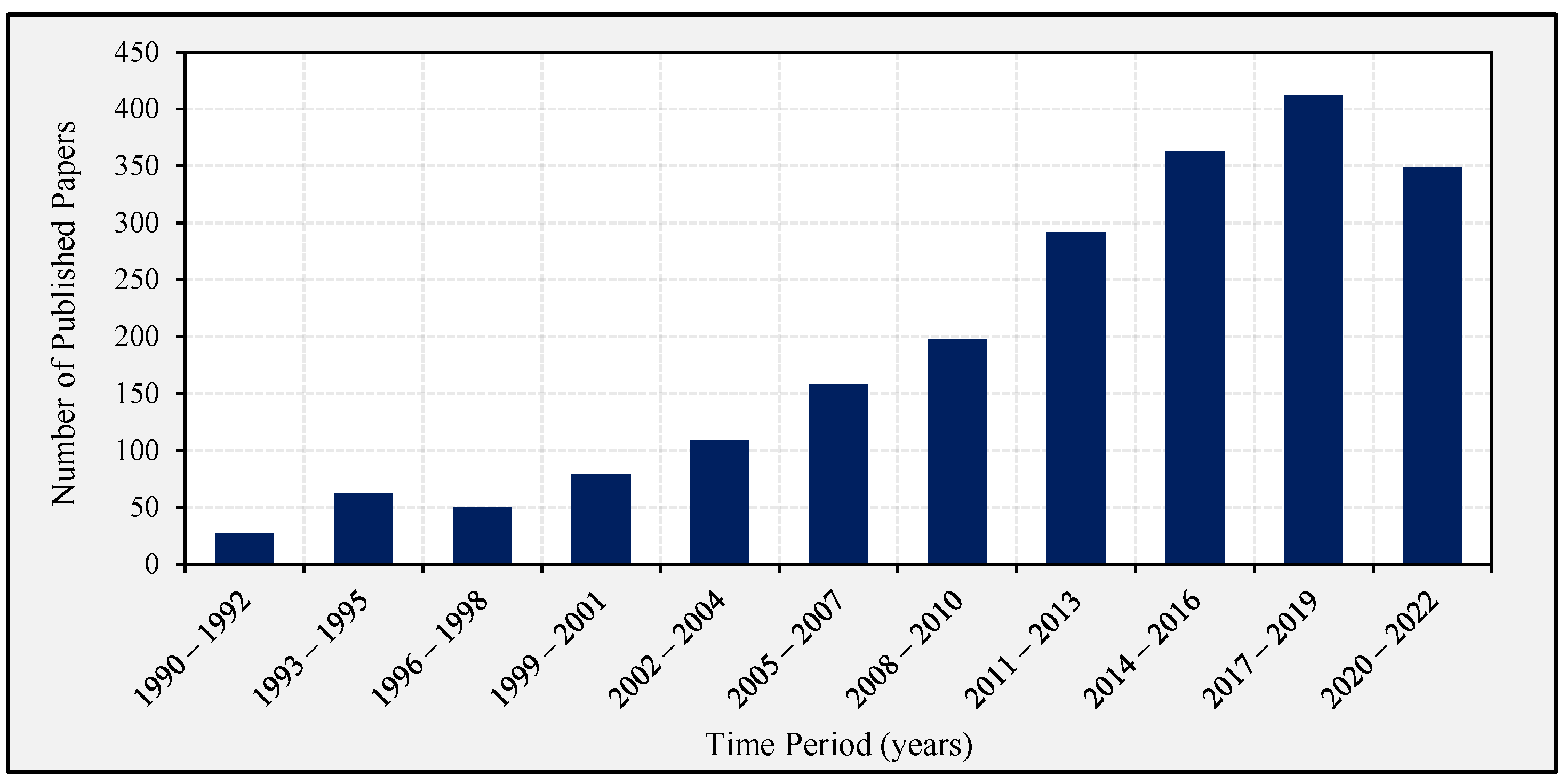
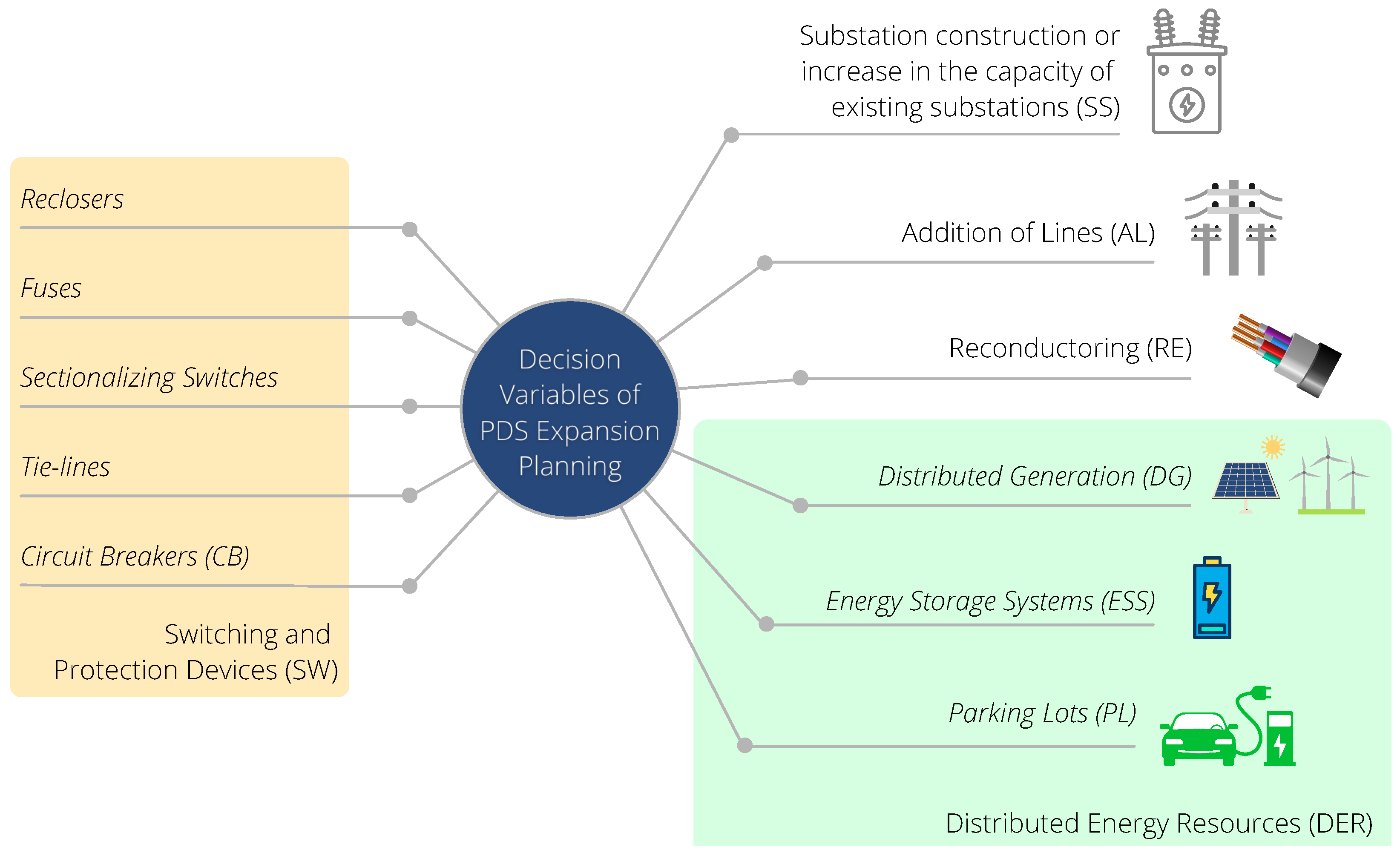
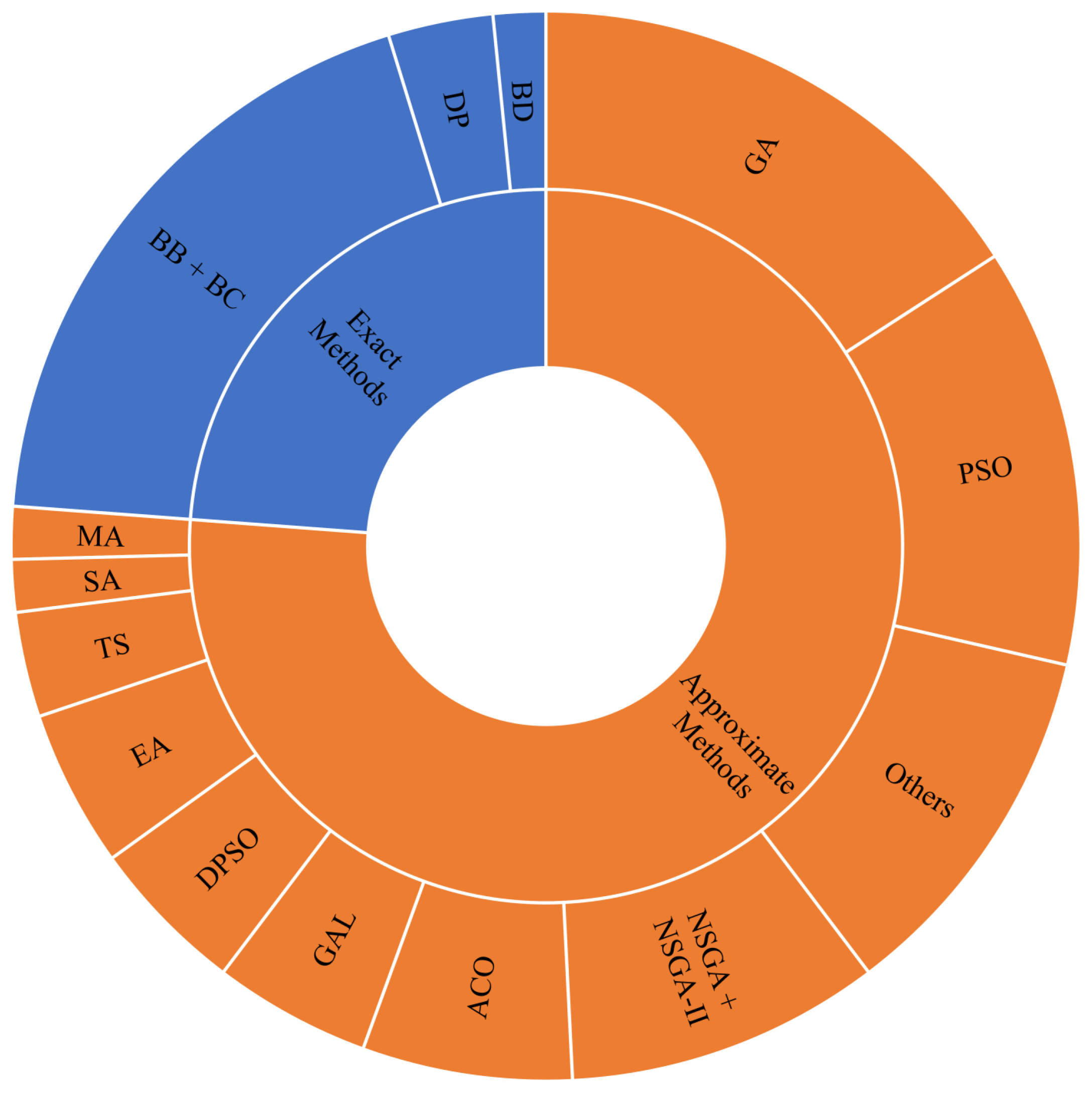
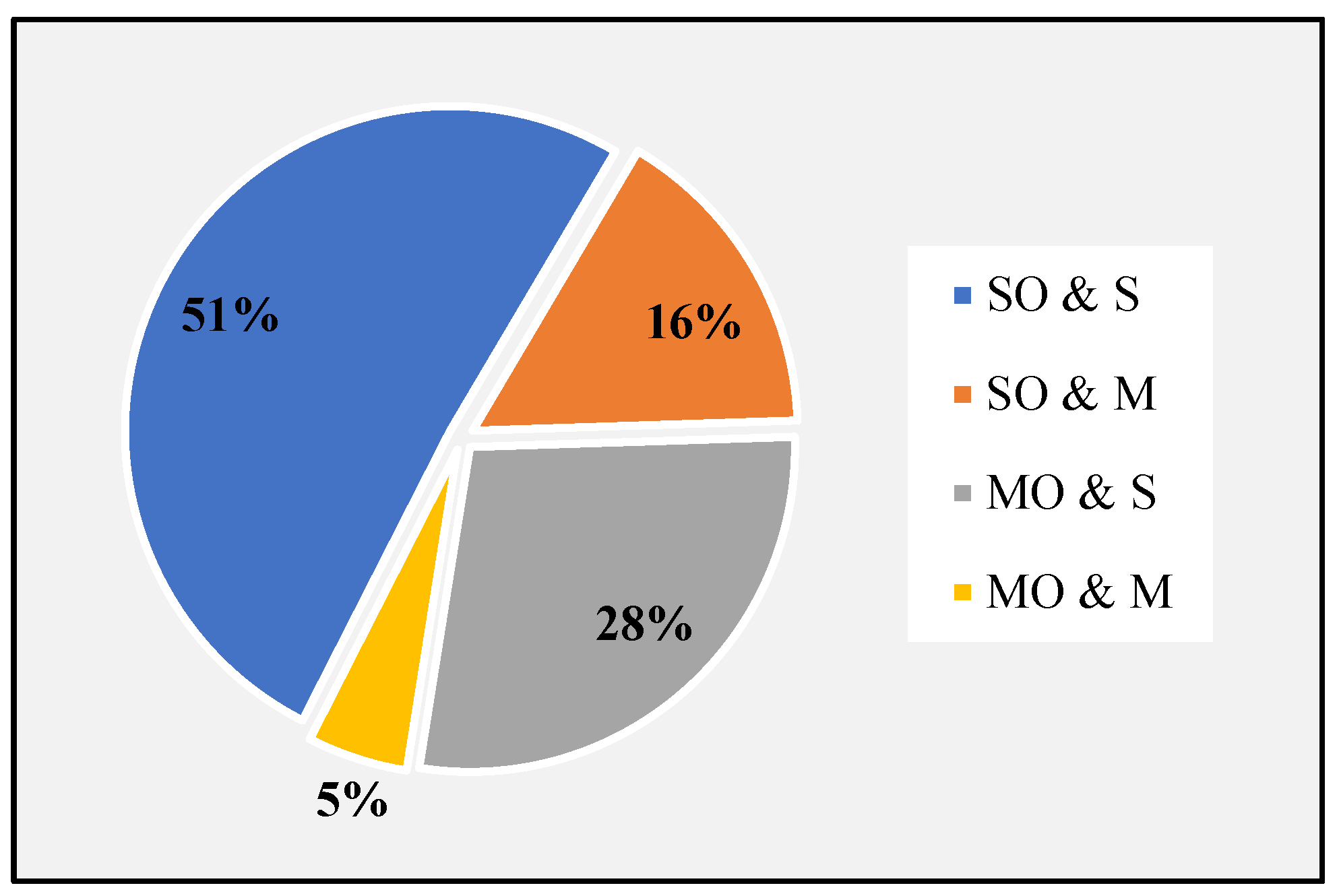
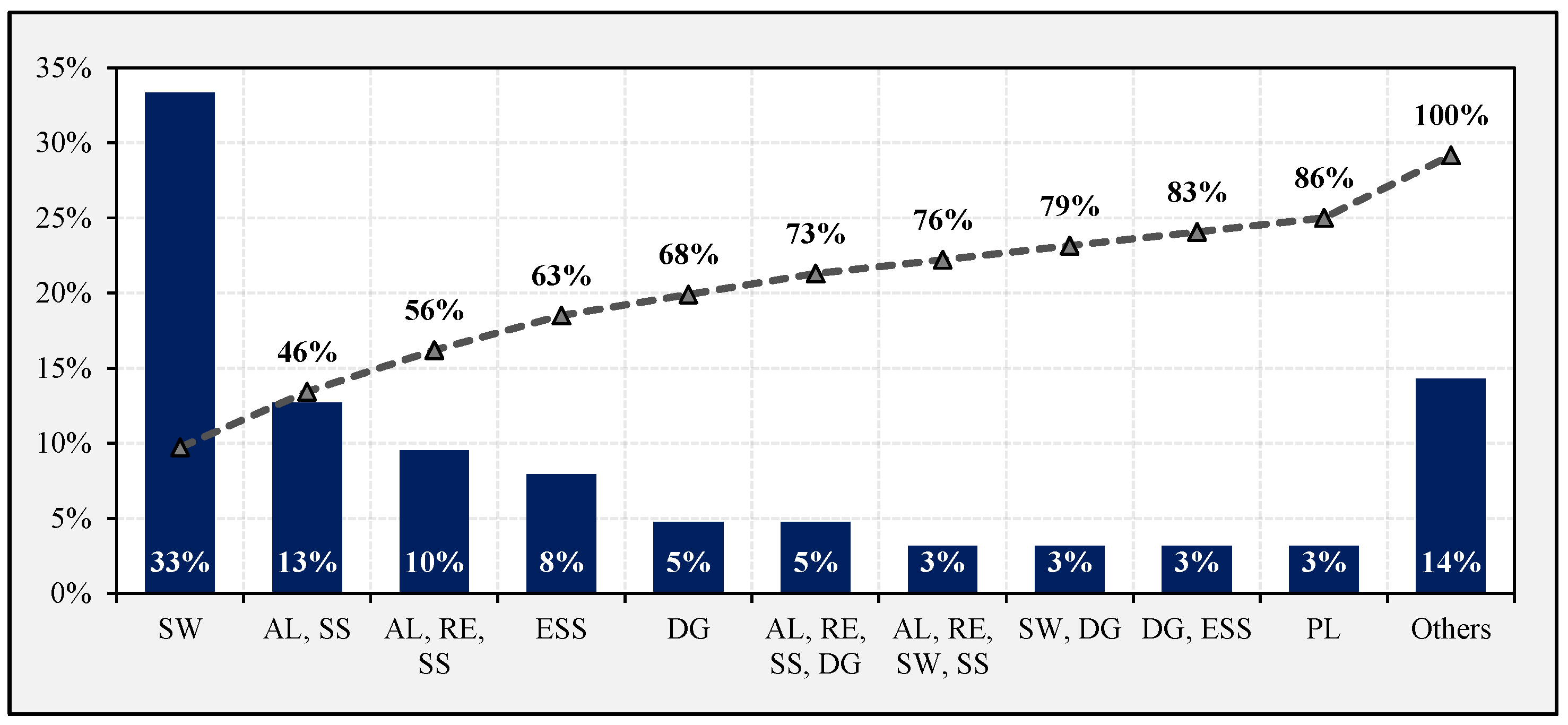
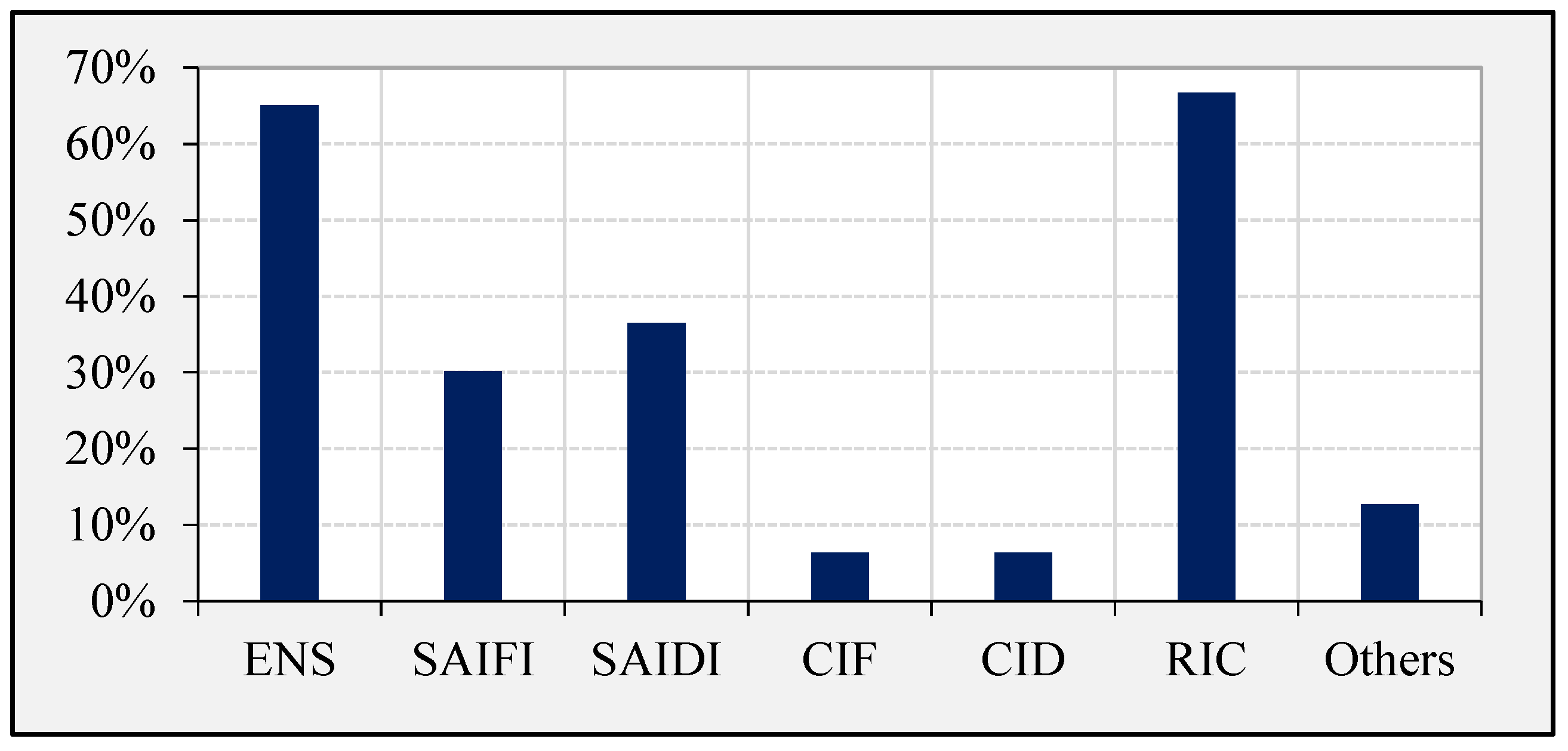
| Reference | Published | Optimization Method | Obj. Type a | Stages b | Decision Variables c | Reliability Indices d | Test System | ||||||||||||
|---|---|---|---|---|---|---|---|---|---|---|---|---|---|---|---|---|---|---|---|
| SO/MO | S/M | AL * | RE | SW | SS | DG | ESS | PL | ENS | SAIFI | SAIDI | CIF | CID | RIC | Others | ||||
| [53] | 1996 | Approximate | SO | S | 🗸 | 🗸 | 🗸 | 🗸 | RBTS bus-4/6 | ||||||||||
| [75] | 2000 | Approximate | SO | S | 🗸 | 🗸 | 🗸 | real 22-node | |||||||||||
| [77] | 2001 | Approximate | SO/MO | S/M | 🗸 | 🗸 | 🗸 | 🗸 | real 182-node | ||||||||||
| [74] | 2002 | Approximate | SO | S | 🗸 | 🗸 | 🗸 | real 396-node | |||||||||||
| [54] | 2003 | Approximate | SO | S | 🗸 | 🗸 | 178 buses | ||||||||||||
| [78,113] | 2004, 2006 | Approximate | MO | S | 🗸 | 🗸 | 🗸 | real 182-node | |||||||||||
| [88] | 2005 | Approximate | MO | S | 🗸 | 🗸 | 🗸 | 🗸 | 🗸 | 142-node | |||||||||
| [79] | 2006 | Approximate | MO | S | 🗸 | 🗸 | 🗸 | 🗸 | 100-node | ||||||||||
| [55] | 2006 | Exact | SO | S | 🗸 | 🗸 | RBTS bus-5 | ||||||||||||
| [92] | 2006 | Approximate | SO | S | 🗸 | 🗸 | 🗸 | 🗸 | real 43-node | ||||||||||
| [58] | 2006 | Approximate | SO | S | 🗸 | 🗸 | 🗸 | 🗸 | real 92-node | ||||||||||
| [89] | 2006 | Approximate | SO | S | 🗸 | 🗸 | 🗸 | 🗸 | 🗸 | 69-bus | |||||||||
| [80] | 2006 | Approximate | MO | S | 🗸 | 🗸 | 🗸 | 43-node | |||||||||||
| [59] | 2008 | Approximate | SO | S | 🗸 | 🗸 | IEEE 123-node | ||||||||||||
| [93] | 2008 | Approximate | SO | S | 🗸 | 🗸 | 🗸 | 🗸 | 394-bus | ||||||||||
| [57] | 2009 | Approximate | MO | S | 🗸 | 🗸 | real 53-bus | ||||||||||||
| [56] | 2009 | Approximate | MO | S | 🗸 | 🗸 | 🗸 | 🗸 | real 51-bus | ||||||||||
| [90] | 2011 | Approximate | SO | S | 🗸 | 🗸 | 🗸 | 9-node | |||||||||||
| [81] | 2011 | Approximate | SO/MO | S | 🗸 | 🗸 | 🗸 | 🗸 | real 182-node | ||||||||||
| [84] | 2011 | Exact | SO | M | 🗸 | 🗸 | 🗸 | 🗸 | 🗸 | 🗸 | 🗸 | 🗸 | 🗸 | 🗸 | 27-node | ||||
| [76] | 2011 | Approximate | SO | S | 🗸 | 🗸 | 🗸 | 🗸 | 🗸 | 72-node | |||||||||
| [60] | 2012 | Exact | SO | S | 🗸 | 🗸 | RBTS bus-4 | ||||||||||||
| [82] | 2012 | Approximate | MO | S | 🗸 | 🗸 | 🗸 | 🗸 | 🗸 | 100-node | |||||||||
| [91] | 2013 | Approximate | SO | S | 🗸 | 🗸 | 🗸 | 🗸 | real 38-node | ||||||||||
| [94] | 2013 | Approximate | SO | M | 🗸 | 🗸 | 🗸 | 🗸 | 🗸 | 205-bus | |||||||||
| [2] | 2013 | Approximate | MO | M | 🗸 | 🗸 | 🗸 | 🗸 | 🗸 | 18-node | |||||||||
| [83] | 2013 | Exact | SO | S | 🗸 | 🗸 | 🗸 | 🗸 | 🗸 | 100-node | |||||||||
| [109] | 2013 | Approximate | MO | S | 🗸 | 🗸 | 🗸 | 9-bus | |||||||||||
| [98] | 2013 | Approximate | SO | M | 🗸 | 🗸 | 🗸 | 🗸 | 🗸 | 🗸 | 🗸 | 67-node | |||||||
| [99] | 2014 | Approximate | SO | S | 🗸 | 🗸 | 🗸 | 33-bus | |||||||||||
| [108] | 2015 | Approximate | MO | M | 🗸 | 🗸 | 🗸 | 🗸 | 🗸 | 24-node | |||||||||
| [62] | 2015 | Approximate | SO | S | 🗸 | 🗸 | 🗸 | 🗸 | real 472-node | ||||||||||
| [61] | 2015 | Approximate | MO | S | 🗸 | 🗸 | 🗸 | IEEE 123-node | |||||||||||
| [95] | 2015 | Approximate | SO | S | 🗸 | 🗸 | 🗸 | 🗸 | 🗸 | 🗸 | 🗸 | real 104-node | |||||||
| [100] | 2015 | Approximate | SO | S | 🗸 | 🗸 | 🗸 | 🗸 | real 30-bus | ||||||||||
| [69] | 2016 | Approximate | MO | S | 🗸 | 🗸 | 🗸 | 🗸 | real 94-bus | ||||||||||
| [63,64] | 2016, 2016 | Approximate | SO | S | 🗸 | 🗸 | 🗸 | 1069-node | |||||||||||
| [26] | 2016 | Exact | SO | M | 🗸 | 🗸 | 🗸 | 🗸 | 🗸 | 🗸 | 🗸 | 🗸 | 🗸 | 🗸 | 138-node | ||||
| [110] | 2016 | Approximate | MO | S | 🗸 | 🗸 | 🗸 | 🗸 | 54-node | ||||||||||
| [70] | 2016 | Approximate | SO/MO | S | 🗸 | 🗸 | 🗸 | 🗸 | real 70-node | ||||||||||
| [106] | 2017 | Approximate | MO | S | 🗸 | 🗸 | 🗸 | 🗸 | real 94-node | ||||||||||
| [97] | 2018 | Approximate | MO | S | 🗸 | 🗸 | IEEE 123-node | ||||||||||||
| [85] | 2018 | Exact | SO | M | 🗸 | 🗸 | 🗸 | 🗸 | 🗸 | 54-node | |||||||||
| [65] | 2018 | Exact | SO | S | 🗸 | 🗸 | RBTS bus-4 | ||||||||||||
| [71] | 2018 | Approximate | MO | S | 🗸 | 🗸 | 🗸 | real 135-bus | |||||||||||
| [72] | 2019 | Approximate | SO | S | 🗸 | 🗸 | 🗸 | 1069-node | |||||||||||
| [96] | 2019 | Exact | SO | M | 🗸 | 🗸 | 🗸 | 🗸 | 🗸 | 🗸 | 🗸 | 🗸 | 54-node | ||||||
| [66] | 2019 | Approximate | SO | S | 🗸 | 🗸 | 🗸 | 🗸 | 🗸 | real 94-bus | |||||||||
| [67] | 2020 | Exact | SO | S | 🗸 | 🗸 | 🗸 | 🗸 | real 144-node | ||||||||||
| [104] | 2020 | Approximate | SO | S | 🗸 | 🗸 | 🗸 | 69-bus | |||||||||||
| [111] | 2020 | Approximate | SO | S | 🗸 | 🗸 | 🗸 | 🗸 | RBTS bus-4 | ||||||||||
| [68] | 2020 | Exact | SO | S | 🗸 | 🗸 | 🗸 | 🗸 | 🗸 | 🗸 | 54-node | ||||||||
| [73] | 2020 | Approximate | SO | S | 🗸 | 🗸 | 🗸 | 69-bus | |||||||||||
| [86] | 2021 | Exact | SO | M | 🗸 | 🗸 | 🗸 | 🗸 | 🗸 | 🗸 | 🗸 | 138-node | |||||||
| [27] | 2021 | Exact | SO | M | 🗸 | 🗸 | 🗸 | 🗸 | 🗸 | 🗸 | 🗸 | 🗸 | 🗸 | 🗸 | 54-node | ||||
| [101] | 2021 | Approximate | SO | S | 🗸 | 🗸 | 🗸 | 🗸 | 69-bus | ||||||||||
| [105] | 2021 | Exact | SO | M | 🗸 | 🗸 | IEEE 34-bus | ||||||||||||
| [112] | 2021 | Approximate | MO | S | 🗸 | 🗸 | 🗸 | 🗸 | IEEE 37-node | ||||||||||
| [102] | 2022 | Approximate | SO | S | 🗸 | 🗸 | 🗸 | 🗸 | 69-bus | ||||||||||
| [103] | 2022 | Approximate | SO | S | 🗸 | 🗸 | 🗸 | 🗸 | 🗸 | IEEE 123-bus | |||||||||
| [87] | 2022 | Exact | SO | M | 🗸 | 🗸 | 🗸 | 🗸 | 🗸 | 54-node | |||||||||
Publisher’s Note: MDPI stays neutral with regard to jurisdictional claims in published maps and institutional affiliations. |
© 2022 by the authors. Licensee MDPI, Basel, Switzerland. This article is an open access article distributed under the terms and conditions of the Creative Commons Attribution (CC BY) license (https://creativecommons.org/licenses/by/4.0/).
Share and Cite
Aschidamini, G.L.; da Cruz, G.A.; Resener, M.; Ramos, M.J.S.; Pereira, L.A.; Ferraz, B.P.; Haffner, S.; Pardalos, P.M. Expansion Planning of Power Distribution Systems Considering Reliability: A Comprehensive Review. Energies 2022, 15, 2275. https://doi.org/10.3390/en15062275
Aschidamini GL, da Cruz GA, Resener M, Ramos MJS, Pereira LA, Ferraz BP, Haffner S, Pardalos PM. Expansion Planning of Power Distribution Systems Considering Reliability: A Comprehensive Review. Energies. 2022; 15(6):2275. https://doi.org/10.3390/en15062275
Chicago/Turabian StyleAschidamini, Gustavo L., Gederson A. da Cruz, Mariana Resener, Maicon J. S. Ramos, Luís A. Pereira, Bibiana P. Ferraz, Sérgio Haffner, and Panos M. Pardalos. 2022. "Expansion Planning of Power Distribution Systems Considering Reliability: A Comprehensive Review" Energies 15, no. 6: 2275. https://doi.org/10.3390/en15062275
APA StyleAschidamini, G. L., da Cruz, G. A., Resener, M., Ramos, M. J. S., Pereira, L. A., Ferraz, B. P., Haffner, S., & Pardalos, P. M. (2022). Expansion Planning of Power Distribution Systems Considering Reliability: A Comprehensive Review. Energies, 15(6), 2275. https://doi.org/10.3390/en15062275










